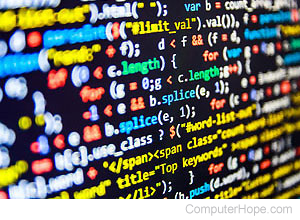Syntax

With a programming language, syntax is a set of rules for grammar and spelling. In other words, it means using character structures that a computer can interpret. For example, if a user tries to execute a command without proper syntax, the compiler finds this error and generates a syntax error, usually causing the program to fail.
What is syntax highlighting?
In a text editor or IDE (integrated development environment) that supports syntax highlighting, the programming language's syntax elements (keywords, variable names, operators, etc.) are colored, making it easier to read the code.
How do you prevent a syntax error?
Syntax errors happen when a command is typed improperly in a command line or when an error is found in a program or script. To prevent syntax errors, the command or code must be written without any mistakes in the syntax.
How to fix a syntax error
To fix a syntax error, the person or developer who wrote the command or code must debug where the error occurred. The compiler or interpreter often gives you the line number of where the error occurred. If a line number is given, start at that line or look around that line for any mistakes.
For example, in HTML (hypertext markup language), you may get a syntax error or other error because an HTML tag is not typed correctly or something is not properly escaped. With programming, there are many reasons why a syntax error could occur. Make sure lines requiring a semicolon (;) at the end of the line have one, there's no extra spacing or characters, and special characters are escaped.
